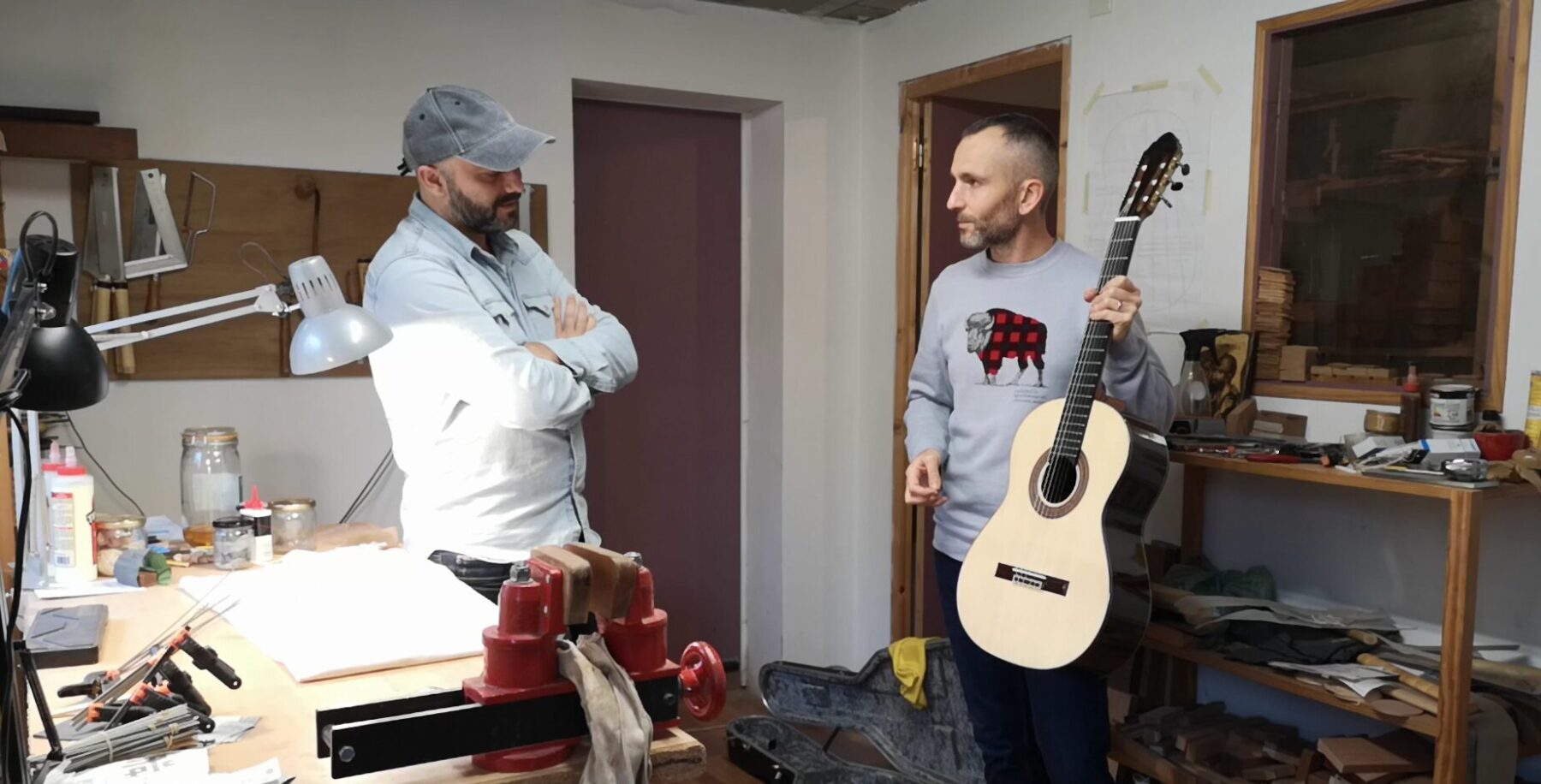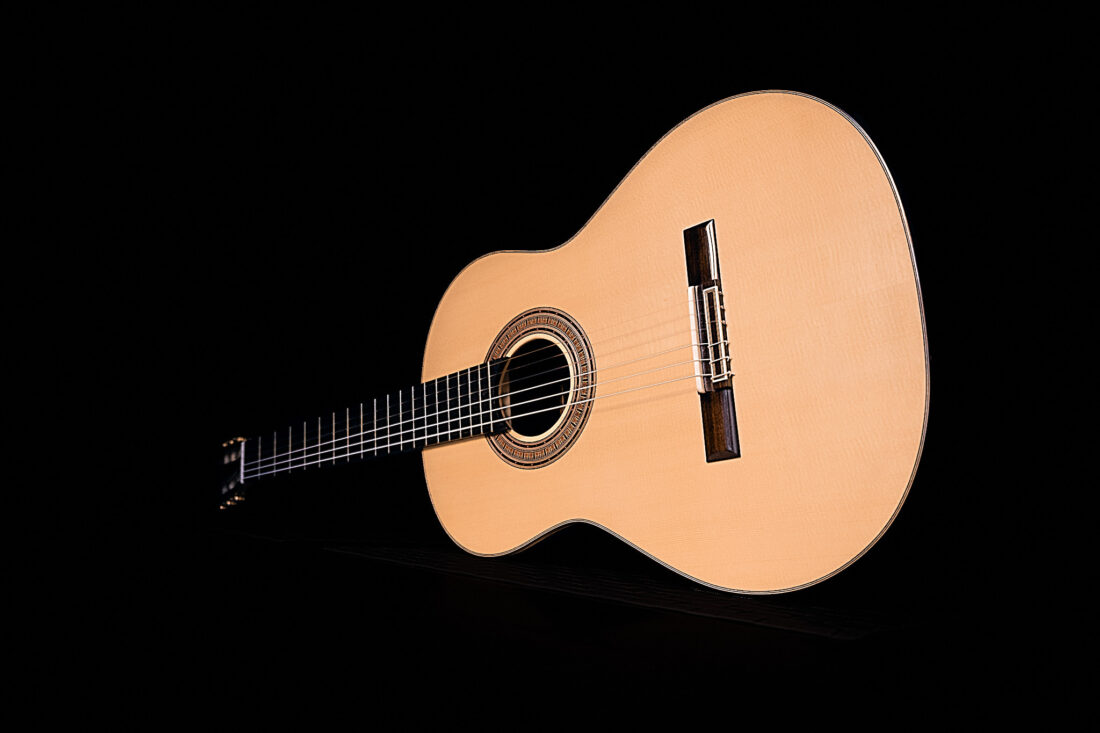Interview Transcription:
I first started the music as a guitarist
And at a very young age
I wanted to become a concert classical guitarist
So I followed a traditional course at the conservatory
but also at school where I benefited from
a school system with schedules arranged
with a classical schooling in the mornings
and the conservatory of music at the afternoons
and that since the age of 11 years till the bachelor
So I had a fairly simple course
with a steady progression
toward my gold medal at the Conservatory of Lille
in northern France.
So I got the gold medal
In France corresponds to the end of the upper cycle
Then I joined Roland Dyens’ guitar class
at the Paris Conservatoire
after having passed the difficult entrance exam.
So I headed for a careeras a professional musician
But at that time already
I began to feel limits
on the level of feeling on stage
I had a lot of jitters,
fears, my hands were shaking
I was not very comfortable with this environment
and it is in parallel of these fears
that grew every day
that I met a luthier who offered to do an internship
where I will make a guitar in his workshop
my own guitar
The goal was certainly not to become luthier
So I continued my studies at the conservatory
and at the same time I spent one day per week
to build this guitar
which was finished after 4 months
And when I finished this instrument
I loved the construction process so much
that I wanted to make another
but only by myself this time
So I built a second guitar that was not successful at all
So of course I wanted to make a better one
and progress again,
which led me to make a fourth, then a fifth, etc.
At the end of my studies at the Paris Conservatoire
I became a guitar teacher
a job I held for 7 years
and I continued during this period to build guitars at home
as an amateur,on my free time
And finally after 7 years
I had already made 30 guitars
and I found that my work was starting to bear fruits
to be good enough and almost professional
so I decided to leave my teaching job
to become luthier.
I changed my career orientation in 2009
more than 10 years ago
So I was in the north of France
and I decided to change region
and start my own business to start a new life
At first of my luthier’s career
I worked a lot on a
modern approach of the guitar making
and I am more known for my guitars
with openings on that side
I did a lot of acoustic research
that led to the creation of my model “Maestro hf”
and this period spans about 8 years
Months ago, around two years
I started a research work
outside the context of the luthery
on the symbolism in general
and broader notions of spirituality
outside a religious or mystical frame
It was more of a deep research on symbols
that led me to discover the sacred geometry
of French cathedrals
and without knowing
where it would lead me at the beginning
since it was simply a personal research
to enrich my knowledge and culture
The idea was born that all this research
could serve meto design a new instrument
My “Maestro hf” is very up-to-date
and fits perfectly with our time
but I found that these beautiful cathedrals
had something more timeless
going through the story
and I wanted to create a guitar
that could be both anchored
perfectly in the present
but who can also go through history
So I also began to study the “masters” of guitar making
Torres, Hauser etc.
and I tried to understand their state of mind
their way of working, their innovations
We know for example that Torres
did not develop a single guitar
that he would have reproduced constantly
but on the contrary seek to improve
his guitars by always innovating
Then I wanted to make a guitar
that inherits
all the acoustic innovations of my “modern” instruments
but that can also benefit from my research
research on the symbolism
and sacred geometry of cathedrals
hoping to achieve a timeless instrument
that can also go through time.
So I drew the guitar “Alkemia”
by starting from a blank sheet
and trying to integrate
all the new knowledge acquired.
Regarding the tools it’s very simple
I never worked the wood before becoming luthier
since I was a guitar teacher
And when I started making instruments
I had very little means
and therefore very few tools.
So I learned to work with almost nothing
and often even tools of poor quality
I finally developed my know-how
much more than my tools.
And then out of habit
I continued to use rather rudimentary tools
and I did not have the idea to develop
this material that I know well
and especially that I master now.
This guitar is a model of the series “Alkemia”
inspired by cathedrals.
Above all, it must be understood
that there is no a different guitar
for each cathedral studied
but a global and structural conception
of the instrument.
I did some acoustic and mechanical research
for this series,
notably by integrating the so-called
“sacred” mathematical and geometrical proportions
of the cathedral of Chartres
because I really like it
It is rich in symbols
and it is this one that inspired me the most at first
Alkemia is thus conceived after the study
of the plans of the cathedral of Chartres
My idea was to design the series Alkemia
on the Cathedral of Chartres and then to evolve the series
by paying tribute to other great cathedrals.
This particular guitar is based on Strasbourg Cathedral
which has the particularity of having only a rose window.
Its acoustic design is identical
to the whole series,
however certain elements the instrument will be determined
by the choice of the cathedral, here Strasbourg.
For example, the rosette has elements
that can be recognized the stained glass of the cathedral.
The label is representative
of architectural elements of the building etc …
To sum up, the design is unique for all models
however the evolutions are more aesthetic.
The best way to recognize the chosen cathedral
is to first look at the rosette
as it is a major decorative element.
This one is inspired by the stained glass window
but others will follow \Nand will be able to find their inspiration
in other elements of the architecture
according to the creativity of the moment
and which will probably guide me towards something new!
I paid tribute to Strasbourg Cathedral through
this more traditional guitar
but I also wanted to pay tribute
to the great historical masters
and to the French guitar making school
which is recognized worldwide.
Who does not know Dominique Field
who is today the leader of this French lutherie,
heir to Bouchet
and Friederich who remains for me
one of the most important luthiers.
I indeed played one of his guitars
when I passed my gold medal at the conservatory.
My teacher at that time had kindly lent me his Friederich
and this instrument has left a mark and deeply touched.
And so through the sculpture
that I propose on the head of my guitar Alkemia,
I pay tribute to Daniel Friederich (known for his \N”lancette” carved)
and more widely to the French school of guitar making.
Yes the head is totally frenchpolished
but I propose two different textures,
one satin and the other bright,
it is also quite difficult to achieve \Nalthough it is purely aesthetic
and I dare to believe that this “demonstration”
« savoir-faire » do honor to this French school
of which I am a part.
I work the ergonomics of my instrument
to make it as easy as possible to play.
This is made possible in particular by some
technical adjustments such as
ebony fingerboard that is not quite flat
but has a curvature along its length
while also being inclined on the bass side,
allowing an optimal balance of saddle at the bridge.
The neck has an asymmetrical curve
which allowsin my sense
of total comfortable playability
I make the guitar as if it were intended for me.
even though I am not sure I can explain it fully
because there is a more symbolic dimension
made possible by all research I have done on cathedrals.
I have the habit of working a lot
and being totally immersed
when I discover an area that fascinates me.
I read all the publications,
all the books related to it in order
to immerse myself in all aspects.
And when I feel that everything is integrated in me,
I try to transcribe it in a more subtle way,
that is to say here to capture the spirit,
“the spirit” of the cathedral or the symbolic element.
I look at the cathedral in all its aspects for
days, weeks, and one day comes \Nthe element that speaks to me.
And when I found it, I do not try
to reproduce it identically
since the stained glass windows are often representative,
I simply try to grasp the spirit,
the color, the symbolic meaning
and I create then a rose window
that when viewed as a whole
leaves no doubt about the cathedral chosen,
but when viewed more closely only
reveals elements suggested or more abstract.
when I make my Maestro model guitars
I used to make 7 or 8 guitars in a year
but the series Alkemia,
imposes a more limited production
because of all this research,
all the fineness of the details,
the frenchpolish that requires a long work etc.
Everything I make myself
It takes me about 3 months,
even 3 months and a half to build one Alkemia\NSo it takes long time.
During my research on cathedrals,
I learned a lot about its symbolic aspect
but also about its”alchemical” aspect,
in the more medieval sense of the word
which is more related to spirituality.
“Alchemy” is of Arab origin.
And the word for it is’ Al kimiya,
which means Philosopher’s Stone.
I found that this word
was perfectly adapted to the instrument
and had a timeless,
spiritual but also international dimension.
I chose a simplified spelling to keep it universal.
What I want in priority is a guitar that sounds
like a guitar,
not like a piano or an organ.
This is very important in my quest
because today many modern guitars,
double top or lattice for example,
have sound colors too synthetic for my taste
and whose character is often percussive
and more reminiscent of the piano.
I’m always searching for sure
but my idea is to be able to benefit
from certain qualities called “modern”
such as balance power, projection, ease of play,
the balance through all registers
but without denying
the “organic” character of the guitar
that is the sound we love
The ideal would be a guitar
with qualities of color
inherited from the great masters
of guitarmaking of the past and
some guitars that sound wonderful,
associated with the most modern qualities
that have been described before.
I do not know if I achieved such a goal
but I do the best every time.
Every guitar I build always surprises me!
And it’s always a good surprise so I continue!


























